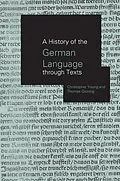A History of the German Language Through Texts examines the evolution of German, from the Early Medieval period to the present day.
Written in a lively and accessible style, the book looks at the history of German through a wide range of texts, from medical, legal and scientific writing to literature, everyday newspapers and adverts. All texts are translated and accompanied by commentaries. The book also offers a glossary of technical terms and abbreviations, a summary of the main changes in each historical period, a guide to reference material, and suggestions for further reading.
A History of the German Language Through Texts is essential reading for students of German, Linguistics or Philology.
Autorentext
Thomas Gloning, Christopher Young
Zusammenfassung
What is language and what is the nature of the intelligence that can acquire it? This volume, originally published in 1976, describes 10 years of research devoted to these questions. The author describes his programmatic research of decomposing language into atomic constituents, designing and applying training programs for teaching these to chimpanzees, and for teaching chimps major human ontological categories, as well as for interrogative, declarative, and imperative sentence forms. The volume details the progress from teaching apes simple predicates such as same-different, to more complex predicates such as if-then, and the success of the program led to the following questions directly related to intelligence: What made the training program effective? What is the cognitive equipment of the species which enables it to learn language? What does this tell us about human intelligence? The answers were suggested in terms of conceptual structure, representational capacity, memory and the ability to handle second-order relations. The results of this experimentation, which resulted in synonymy in some animals, shed light not only on the nature of language, but the nature of intelligence as well.One of the earliest ape language and intelligence studies, today this classic can be read and enjoyed again in its historical context.
Inhalt
1: Introduction; 2: Pre-textual German; 1: Old High German (c.750-c.1050); 3: The Lord's Prayer; 4: Heroic Lay; 5: Legal code; 6: Political treaty; 7: Gospel harmony; 8: Political praise poem; 9: Phrasebook; 10: History; 2: Middle High German (c.1050-c.1350); 11: Williram of Ebersberg; 12: Courtly romance; 13: French influence; 14: Legal Documents; 15: Legal code; 16: Mysticism; 17: Medicine; 3: Early New High German (c.1350-c.1700); 18: Humanism and linguistic levelling; 19: Low German and the language of business; 20: Language use for special purposes; 21: Language use in the early mass media; 22: Bible translation; 23: Purism in the seventeenth century; 24: Dialect; IV: New High German (c.1700-c.1945); IV 25: 'Natural style'; IV 26: J.W. Goethe; IV 27: Political pamphlets; IV 28: A History of the German Language through Texts; IV 29: Industrialization, technology and language; IV 30: Elements of everyday language use; IV 31: Scientific prose in the nineteenth century; IV 32: National Socialism; V: Contemporary German (c.1945-2000); V 33: The language of the GDR; V 34: The public sphere; V 35: English Influence; V 36: Newspapers; V 37: Jugendsprache
